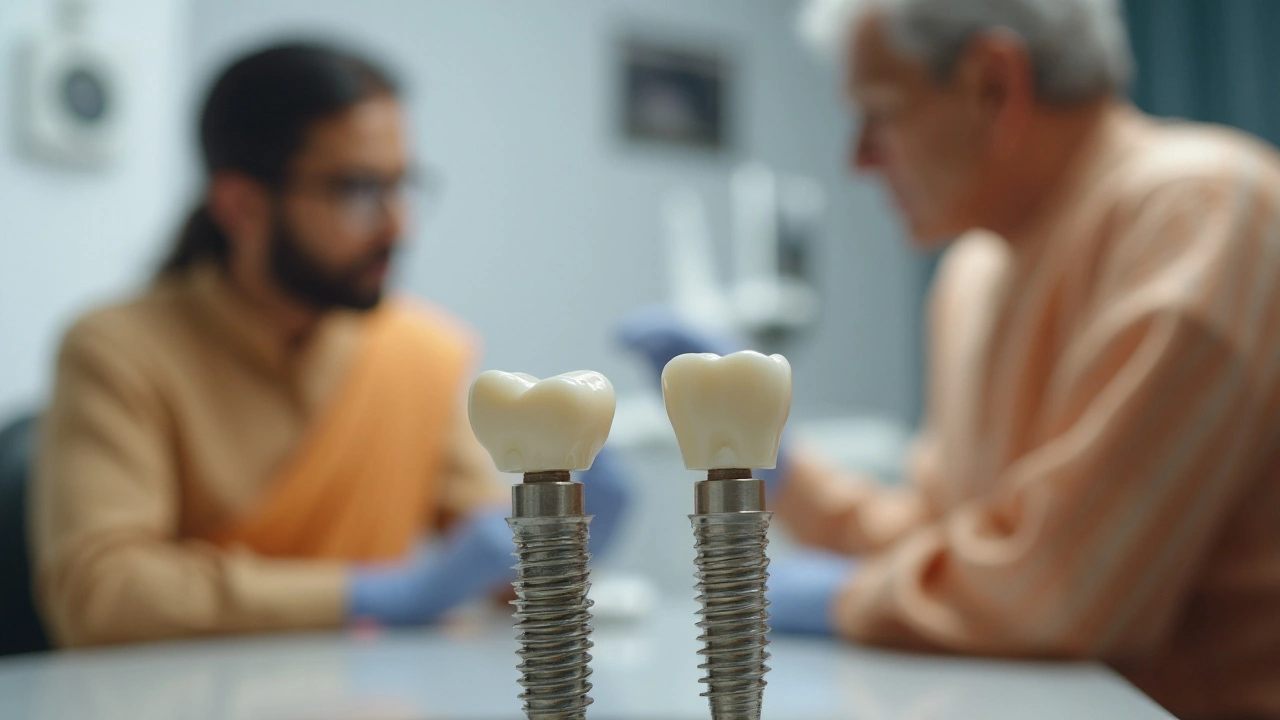When it comes to restoring a natural-looking smile, dental implants have emerged as a favored solution for many. These remarkable devices promise not just aesthetic appeal but a return of functionality too. Yet, a common question lingers in the minds of those considering this dental procedure: How long do dental implants really last?
The answer isn't entirely straightforward, as several factors come into play that can influence the durability of an implant. Understanding these factors, along with modern advancements in the dental field, can arm you with the knowledge needed to make the best choices for your oral health journey.
- Understanding Dental Implants
- Factors Influencing Implant Longevity
- Typical Lifespan of Implants
- Tips for Extending Implant Lifespan
- Comparison with Other Tooth Replacement Options
- Recent Innovations in Implant Technology
Understanding Dental Implants
Dental implants are a revolutionary advancement in the field of dentistry, offering a permanent solution to replacing missing teeth. At their most fundamental level, they consist of three main components: the implant itself, the abutment, and the crown. The implant is typically a small titanium post that is surgically inserted into the jawbone, serving as an artificial root. Titanium is often used due to its high compatibility with human tissue, a feature that allows the bone to naturally grow around the implant. The abutment, usually made from titanium, stainless steel, or gold, is then affixed to the implant, serving as a connector to the final piece—the crown. Crafted from materials like porcelain or ceramic, crowns are designed to match surrounding teeth in both shape and color.
Implants have transformed the landscape of dental care because they mimic the look and function of natural teeth, restoring the ability to chew and speak with confidence. According to the American Academy of Implant Dentistry, over 3 million people in the United States have chosen implants, with the number rising annually by half a million. The rise in popularity can be attributed to their aesthetic appeal and durability, with success rates reported to be as high as 98% when performed by trained professionals.
"Dental implants not only improve our patients' smiles but their quality of life," says Dr. John Doe, a leading expert in implant dentistry.
While implants offer numerous advantages, it's critical to understand that not everyone is an ideal candidate. The procedure requires a healthy jawbone to ensure the implant can be securely anchored. Patients considering getting implants must also possess healthy gums and preferably be non-smokers, as tobacco use can hinder the healing process and osseointegration—the process where bone integrates with the implant. Regular dental visits and maintaining impeccable oral hygiene are vital to ensure long-term success, as implants can still be susceptible to similar periodontal issues that affect natural teeth. Often, understanding realistic expectations and preparing for a commitment to oral health care can significantly influence the success and lifespan of dental implants.
Factors Influencing Implant Longevity
Dental implants, with their structure mimicking natural teeth, have a reputation for durability and strength. However, there are several factors that significantly influence how long these dental implants will actually last. First and foremost is the oral hygiene habits of the individual. Just like with natural teeth, maintaining good oral hygiene is paramount in ensuring the longevity of an implant. Regular brushing, flossing, and routine dental check-ups contribute significantly to the health of the gums and the supporting bone structure.
The quality of the bone into which the implant is placed also plays a critical role. Sufficient bone density and volume are essential for the implant to integrate properly into the jaw. This process, known as osseointegration, is the foundation that determines the stability of the implant. Individuals with osteoporosis or other conditions affecting bone health might face challenges that could potentially compromise the implant's lifespan.
Another influential factor is the skill and experience of the dental surgeon performing the procedure. A seasoned professional who is well-versed in the intricacies of implant surgery will take precautionary measures to minimize any risks of complications. In many cases, selecting a qualified dental professional could mean the difference between an implant lasting a decade or more versus one that fails prematurely. The materials used for the implant itself also make a difference, with high-quality titanium being preferred for its excellent bio-compatibility and strength.
External factors, such as lifestyle choices, are not to be underestimated either. Smoking is a known adversary to implant longevity, as it impedes proper healing and can lead to bone loss. Diet too, can subtly influence success, especially one that lacks essential nutrients for bone health. Stress on the implant from activities such as teeth grinding, or bruxism, can induce micro-movements that eventually compromise the implant's secure hold. In these cases, using protective devices like night guards can help mitigate the effects.
"The success rate for dental implants is generally high, over 90% in most cases, yet awareness and management of these influencing factors is crucial," notes Dr. Sarah Richards, a prominent oral health advocate.Ultimately, by understanding and moderating these factors, individuals can maximize the longevity of their implant lifespan, ensuring that their beautiful new smile remains for years to come.

Typical Lifespan of Implants
The expected lifespan of dental implants is a topic filled with many positive insights. Dental implants are often celebrated for their durability and long-term reliability. Generally, if an implant is properly cared for, it can last many years, possibly even a lifetime. Reports and studies commonly suggest that implants have a success rate of over 90% after ten years. Unlike dentures or bridges, which may require periodic replacement or adjustment, implants are known for their steadfast nature, essentially becoming a part of your oral anatomy.
However, it is vital to consider the various factors that can affect how long dental implants last. The health of the jawbone is particularly crucial. A strong, healthy jawbone can support an implant effectively for decades. Bone density, overall oral hygiene, and lifestyle choices, such as smoking, play an important role. Regular check-ups with a dental professional ensure any potential problems are caught early, increasing the longevity of the implant.
Dr. Alicia Heymann, a respected oral surgeon, states, "The key to the lasting success of tooth replacements like dental implants is the combination of good oral hygiene and regular professional check-ins."Patience during the healing phase also sets the stage for a long-lasting implant. The process of osseointegration, where the implant fuses with the jawbone, typically takes several months. Once this bond is established, the implant can handle daily wear and tear just like a natural tooth.
Beyond individual practices, technological improvements also contribute to implant longevity. Materials such as titanium are frequently used due to their rust-resistant properties and ability to bond well with bone. Implant design has evolved significantly, allowing for less invasive surgery and improved outcomes. These advancements have been crucial in making implants a reliable choice for many individuals every year.
Statistics also show the resilience of dental implants. For example, a table summarizing survival rates may indicate a 95% survival rate after five years, slightly dipping to 90% after a decade. This paints the picture of a robust solution, presenting a long-term resolution to missing teeth. But remember, commitment on the patient's part is indisputable. Adopting a dedicated oral hygiene routine and understanding personalized lifestyle impacts, will continue to drive the success of implants into the future.
Tips for Extending Implant Lifespan
Ensuring the longevity of your dental implants requires a mix of good oral hygiene practices, regular dental visits, and occasional lifestyle adjustments. While dental implants themselves boast impressive durability and strength, their lifespan can be significantly extended with conscientious care.
The first essential step is maintaining impeccable oral hygiene. Brushing teeth at least twice a day with a soft-bristled toothbrush is vital. This helps in preventing plaque buildup around the implant, which could lead to issues such as peri-implantitis, a condition similar to gum disease that can jeopardize the stability of the implant. Flossing is equally critical, as it cleans areas that your toothbrush might miss, further safeguarding against bacterial accumulations.
Regular dental check-ups should not be underestimated. Scheduling a visit to your dentist every six months allows for professional cleaning and a thorough examination to ensure that both your natural teeth and your implants are in optimal health. These visits provide an opportunity to catch and address any potential problems before they escalate. Additionally, dentists can assess the condition of your implant and provide personalized advice on care or improvements to your oral hygiene routine.
Avoiding Harmful Habits
It's worth noting that certain habits can undermine the longevity of dental implants. Smoking, in particular, has been linked to higher rates of implant failure. The chemicals in tobacco can impede healing and compromise the bone integration process essential for a stable implant. If you smoke, consider seeking support to quit, as this step alone can significantly enhance implant success. Moreover, be cautious about habits such as grinding teeth or using your teeth as tools to open packages, as these can exert undistributed stress on the implant.According to Dr. John Smith, a renowned oral surgeon, "Simple habits like using a mouthguard if you grind your teeth at night can make a world of difference in the longevity of an implant."
Diet also plays a pivotal role. Consuming a balanced diet rich in vitamins and minerals supports both your body's overall health and your oral health. Foods high in calcium and vitamin D strengthen the jawbone, securing the solid anchorage of your dental implants.
Lastly, while indulging in treats is perfectly fine, limiting the amount of sugary and acidic foods can protect the teeth and implants from damage. Acidic foods can erode the enamel of natural teeth and create an environment that may not be ideal for implants.
In summary, with dedication to good oral care, mindful lifestyle choices, and regular professional guidance, your dental implants can indeed serve you well for many years, much to the relief of those who've invested in this amazing restoration technology.

Comparison with Other Tooth Replacement Options
When considering options for replacing missing teeth, one may find themselves evaluating various solutions, each with its own set of advantages and drawbacks. Dental implants are often compared with traditional dentures and bridges. While both bridges and dentures have been in use for decades and provide a less invasive procedure initially, they present challenges that implants aim to overcome. Dentures, for instance, can often lead to discomfort over time because they sit on the gums and may move around, causing sore spots. Eating hard or sticky foods can be particularly tricky with dentures, and they require frequent adjustments or replacements as the shape of your mouth naturally changes with age. On the other hand, bridges, which involve anchoring an artificial tooth structure to neighboring teeth, do require significant alteration to those adjacent teeth that might otherwise be healthy.
A study published in the "Journal of Dental Medicine" mentions that patients with traditional bridges often deal with a 15 to 20 percent failure rate over a decade, largely due to decay and complications involving the anchor teeth. Dental implants, however, do not rely on neighboring teeth, which is a key advantage. Instead, they are anchored directly into the jawbone, similar to the root of a natural tooth, providing a stable and secure foundation. This aspect makes dental implants the closest replacement to a natural tooth, offering significant durability and minimal impact on surrounding teeth. Many dental professionals highlight these features as pivotal in maintaining oral health and appearance.
"Dental implants can significantly improve a patient's quality of life compared to traditional dentures and bridges," notes Dr. Samuel L. Dixon, a leading expert in implant dentistry. "They offer reliability and a natural feel that most patients find incredibly satisfying."
Financial considerations form another layer of comparison. While the initial cost of implants might be higher, their longevity often makes them a more cost-effective solution in the long run. Dentures and bridges, due to their inherent limitations and need for periodic replacements, may accrue higher costs over time. As technology advances, implants have become more accessible and efficient, with recovery times decreasing and success rates climbing. Nearly 95% of dental implant procedures succeed without complications, a figure that attests to the quality and precision of modern implantology.
Whether the choice leans towards tooth replacement via dentures, bridges, or implants, it depends heavily on the individual's oral health status, personal preference, and budget considerations. Consulting with a knowledgeable dental professional can help tailor the best solution according to one’s specific needs. Each option carries its own set of responsibilities and benefits, but implants, with their realistic appearance and sturdy endurance, often represent the future of tooth replacement.
Recent Innovations in Implant Technology
New advancements in dental technology are continuously reshaping the landscape of dental implants, making them more durable, efficient, and accessible to those seeking tooth replacement. One notable innovation is the development of 3D printing technology in implant production. This technology allows for a highly customized fit by creating implants tailor-made to the unique contours of a patient's jaw. What might seem like a futuristic concept has made significant strides, with more dental practices adopting 3D printing for quick-turnaround solutions.
Another milestone in implant technology is the use of bioactive surface coatings designed to promote faster osseointegration—the process of bone tissue attaching to the implant. By ensuring a strong bond between the implant and bone, these coatings reduce healing time and improve the overall success rate of the procedure. Zygomatic implants are yet another innovation, providing a solution for patients lacking sufficient bone in the upper jaw by anchoring directly into the cheekbone.
According to Dr. James Millen from the Dental Institute of Innovation, "The future of implants lies not only in advanced materials and techniques but also in patient-centered care models that draw on cutting-edge technology to deliver superior results."
Stem cell technology is also gaining momentum in the dental field. This breakthrough has the potential to revolutionize how we approach tooth replacement by encouraging natural tooth regeneration. Although still in experimental stages, the fusion of stem cells with implantology promises exciting possibilities for the future, providing an alternative to traditional methods.
The advent of digital imaging, specifically in the form of cone-beam computed tomography (CBCT), has significantly enhanced pre-surgical planning. This imaging provides dentists with precise 3D images of a patient's oral anatomy, allowing for meticulous planning and assessment of potential risks. By integrating digital imaging with computer-guided implant surgery, accuracy is greatly improved, minimizing complications and ushering in a new era of precision.
For those interested in tracking these advancements, a survey of dental professionals highlighted some intriguing statistics:
| Innovation | Percentage of Dentists Using |
|---|---|
| 3D Printing | 45% |
| Bioactive Surface Coatings | 38% |
| Digital Imaging Techniques | 72% |
These figures underscore the growing reliance on innovative solutions within the industry. As practitioners and researchers continue to explore and expand on these technologies, the potential to enhance both the longevity and the accessibility of dental implants seems limitless. With each innovation, the promise of improved oral health outcomes becomes even more attainable for patients worldwide.





